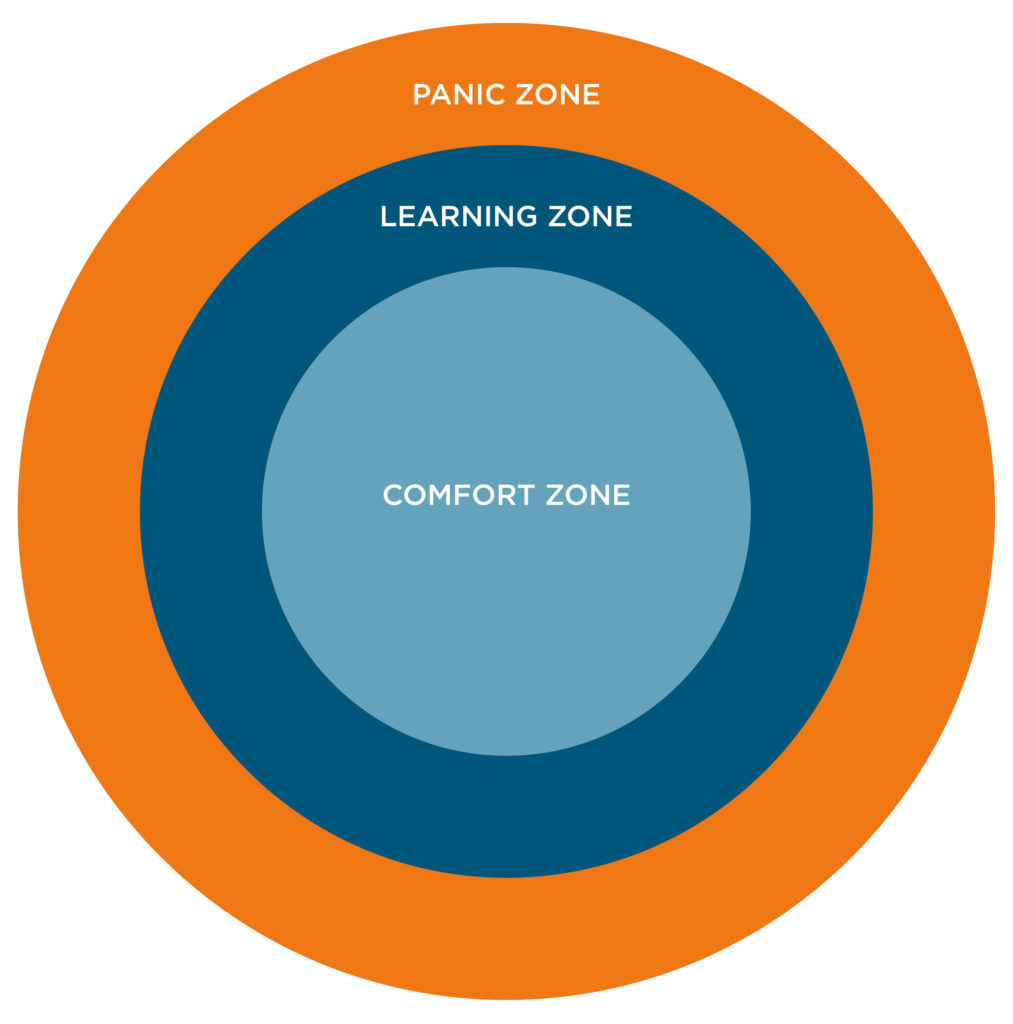In this series, we look at different ways of getting the creative juices flowing. This time, we focus on how you can boost your creativity and maximize productivity by risk-taking and venturing outside of your comfort zone.
Eleanor Roosevelt, first lady of the thirty-second U.S. president Franklin D. Roosevelt and one of America’s most important visionaries and leaders in her own right, dared us to expose ourselves to the risk of failure in order that we might achieve something remarkable. She said, “Do one thing every day that scares you.” And she was right on the money, because experts today agree that risk-taking and creativity go hand in hand, with studies showing that intellectual, or calculated, risk-taking is one of the cornerstones of creativity.
There are several kinds of risk—ethical, financial, and so on—but the kinds of risk that most encourage creativity are social and intellectual, where a person perceives their own risk of failure while also laying themselves open to possible criticism or ridicule from others. This level of anxiety or fear of failure is what pushes us out of the so-called comfort zone and into what psychologists call the growth, or learning, zone (see graphic). Bearing in mind that most of us tend to be risk-averse, Eleanor Roosevelt’s advice is good advice; it challenges us and increases our tolerance for risk, pushing us into the growth zone.
I am always doing that which I cannot do, in order that I may learn how to do it.”
Pablo Picasso
Painter, sculptor, printmaker,
ceramicist and theatre designer
Innovation = Creativity x Risk-Taking
All of the great innovators throughout history, from Leonardo da Vinci to Amelia Earhart, Thomas Edison to Steve Jobs, have one thing in common: that they have proven themselves willing to put their reputations on the line, to lay themselves open to criticism, in the name of innovation. In one of the most watched TED talks of all time, the late Sir Ken Robinson, education and creativity expert, said: “If you’re not prepared to be wrong, you’ll never come up with anything original.”
We can’t all be natural risk-takers, but becoming adept at taking intelligent risks in order to inspire creativity and boost productivity is something we can learn to do. Not only are more and more businesses recognizing that creativity is the cornerstone of innovation, but on a personal level learning to take risks can also lead to greater confidence and success as you continue to expand the boundaries of your comfort zone. Here are our top 5 tips for embracing risk:
- Question what is stopping you from taking risks. Is it fear of failure or criticism? Once you have identified what’s holding you back, you can begin to understand what it is you need to overcome.
- Professionally, make sure you have the support of your superior. It’s important they recognize the value of risk-taking, and encourage it.
- Decide on an innovation you want to champion, and run with it. Focus on success, rather than failure.
- Recognize that risk-taking is learned behavior. And practice. On a personal level, you might try taking up a new hobby or sport, or going for that new look.
- Remember that inaction is the biggest risk of all. As author and motivational speaker Denis Waitley said, “Life is inherently risky. There is only one big risk you should avoid at all costs, and that is the risk of doing nothing.”
The most successful businesses are those that have realized how much innovation depends on creativity, and have consequently given their employees the freedom and the space to experiment, to make mistakes, and most importantly, to learn from those mistakes. These are the companies that have created a culture of innovation by encouraging risk-taking, assuring their employees that it’s acceptable to fail—as long as failure is seen and recognized as a learning experience. It is the fear of failure that kills innovation.
The Mercedes-AMG PETRONAS Formula One team, who have dominated the turbo-hybrid era of F1, is a prime example of an organization that encourages experimentation while avoiding blame culture at all costs. Toto Wolff, who is the CEO, Team Principal, and co-owner of the F1 team, says, “We have a motto that is ‘see it, say it, fix it’, which means that you have to create a safe environment for everybody to speak up.” Mercedes’ senior management approach is to blame the problem, not the person. Wolff goes on: “We’re working really hard on not blaming the person, because the moment you do that people close up like a shell and you won’t see any innovation, you won’t see any risk taking. This is what we want—we are in a risk-taking business, an innovation business.” Successful organizations like the Mercedes F1 team have recognized that to be more innovative, they need their people to be more creative.
The Learning Zone Model illustrates the three stages, or zones, we pass through when we do something completely new, or learn a new skill. Its original conception is attributed to psychologist, Lev Vygotsky. The premise is that in order to learn something successfully, we must be challenged, but the trick is to move out of the comfort zone and push ourselves just hard enough to enter the growth zone, where creativity flourishes. If we push too far, we become overwhelmed, or panicked; in the panic zone, it is all but impossible to learn successfully. Eventually, in the process of learning new things and continuing to push ourselves, it is possible to expand the comfort zone, i.e. the environment within which we feel most comfortable.
The Comfort Zone: the place where you feel most at ease, which might be watching TV, reading a book, or going for a walk in the park. Here, things are familiar and safe, but staying in this zone prohibits development.
The Learning Zone: also known as the Growth Zone, this is the sweet spot, where you are pushed just hard enough to keep you sharp and creative. With time, as you practice taking risks, the Comfort Zone expands, and the more things you are comfortable with.
The Panic Zone: the place to avoid at all costs, this zone is not conducive to learning. Here, the anxiety levels are so high that it is impossible to perform at your best.

No risk, no reward
Creative people naturally tend to be risk-takers. Being labelled as crazy or deluded is water off a duck’s back to creatives, as the passion for creating something novel far outweighs the fear of failure or exposure to criticism. Not everyone is comfortable with taking risks, though, so if you want to be a creative person, then learning how to overcome your fear of failure is something you are going to have to do. We all have the potential to be creative in the right environment. But there is no getting around the fact that without risks, there are no rewards.
- Establish a culture where it’s okay to take risks. Risk-taking leads to creativity leads to innovation. And innovation gives your company a strategic advantage.
- Nobody’s perfect, so encourage your employees to experiment and fail. Failure takes you outside of the comfort zone and into the growth zone, where innovation thrives.
- Lead by example. Senior management needs to demonstrate that risk-taking is both valued and encouraged. They also need to give their employees the freedom, time, and resources to take risks.
What’s the worst that might happen when you present a new idea? A few words of criticism, perhaps? But consider that you might also receive constructive feedback that helps you to tweak your idea, or to come up with a new one. Your idea might be a springboard to an exciting innovation, a new product or service. By focusing on success rather than failure, the reward of your risk-taking is that your idea actually leads to something. And if it doesn’t, so what? Learn from the experience; at least you will have the confidence to try again. Like everything, risk-taking simply takes practice, so that eventually it is something that becomes second nature—a habit that you become comfortable with. It’s important to remember, however, that at the end of the day a good risk is calculated, but not reckless.
Creativity is the bedrock of innovation and of personal growth, and in a world where the rise of the machines is becoming a reality, businesses are placing a premium on learned skills like creativity, an area in which machines and artificial intelligence are still no match for humans. We must simply practice pushing ourselves beyond our comfort zones, overcome our fear of failure, keep on trying, and be prepared to learn from any failures that do happen. Every successful innovator has failed at some point; it’s how we learn, pick ourselves up, improve, and grow. As underdog Rocky Balboa, the title character of Sylvester Stallone’s “Rocky” film series, puts it, “It’s not about how hard you hit. It’s about how hard you can get hit and keep moving forward. That’s how winning is done.”


